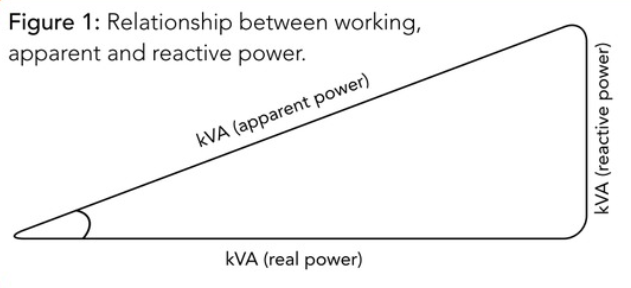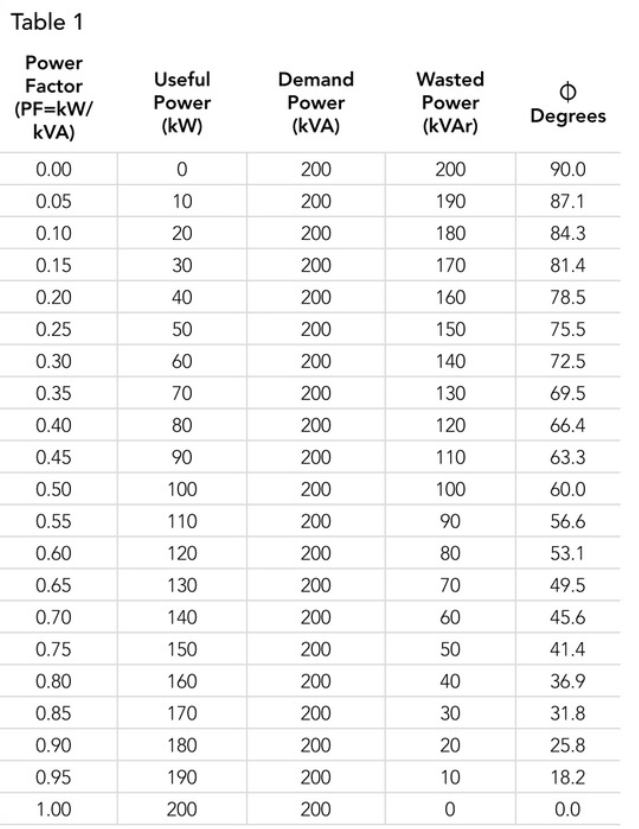KANSAS CITY, MISSOURI, US — As presented in my article on energy cost management in the November 2023 issue of World Grain, there are many hidden charges in the electrical bill that impact milling energy costs. Contractual discussions with the mill’s electrical suppliers as well as internal operational management decisions can reduce demand and peak demand charges.
In addition to basic consumption and demand charges, there are often fixed charges associated with simply being a customer and having a meter that must be monitored and maintained. Various taxes, fees and penalties may be incurred, including late payment fees as well as Power Factor penalties, which are the focus of this article.
What is Power Factor?
Power Factor (PF) is the ratio of true working power delivered by the utility (kW) power and the apparent power (kVA), which represents the demand of the plant performing useful work. The formula is PF = kW/kVA where kW is measured as kilowatt and kVA is kilovolt amperes, also known as demand. PF is a measure of how efficiently incoming power is used.
A load with a low PF draws more current than a load with a high PF for the same amount of useful or true working power delivered. Energy loss in the distribution system is greater and requires larger wires and other equipment. Electric utilities usually will charge a higher fee or penalty to industrial customers with PF lower than 0.95 and in some instances are not required to provide power to customers whose PF drops below 0.85.
Figure 1 presents a graphical relationship between working, apparent and reactive power. As shown, the efficiency or PF is the cosine of the angle between working and apparent power.
 Credit: ©SOSLAND PUBLISHING CO.
Credit: ©SOSLAND PUBLISHING CO.
The relationship between the real or useful power and apparent or demand power is shown in Table 1. PF is the ratio that is dimensionless proportion that some may convert to a percentage to express efficiency of power utilization based on power delivered by the utility. The phase difference between the current and voltage measured in degrees is shown in the last column.
As shown in Figure 2, this phase difference is the result of utilizing alternating rather than direct current.
PF is not applicable to direct circuits (DC) as current, or voltage frequency, is zero. The current and voltage relationship in alternating currents (AC) is shown in Figure 2. Alternating currents have a frequency, generally 50 or 60 HZ (cycles per second) PF that is always between unity -1 and 1, the cosine of the phase difference between V (voltage) and A (current in ampere).
A Leading Power Factor range of -1 to 0 occurs in purely capacitive circuits where current leads the voltage. A lagging Power Factor in the range of 0 to 1 occurs in purely inductive circuits where the current lags the voltage.
Lagging Power Factor is where most industrial and milling operations perform. When current and voltage are in this phase, there is no leading or lagging PF as the PF is 1 or -1, which is only possible in ideal circuits. Power Factors of -1 or 1 indicate there is no reactive power consumed, which is the power used by the circuit, transformers and motors needed to produce or result in magnetic fields.
Often it is desirable to compare AC circuits that are constantly varying in both voltage and current to an equivalent steady DC circuit. The comparison is accomplished using RMS (Root Mean Square) to determine the DC power delivery equivalent of an AC current based on power delivery capabilities.
RMS voltage is calculated by squaring the voltage waveform, finding the average over a single period, and taking the square root of the result. For this article, we can focus on a single-phase AC current as shown in Figure 2. PF provides an understanding of the efficiency of the plant’s electrical system indicating how much power supplied by the power supplier will perform useful work. As PF approaches unity (1), efficiency is improving, and power loss or reactive power is minimized. This benefits both the electric company and the miller.
 Credit: ©SOSLAND PUBLISHING CO.
Credit: ©SOSLAND PUBLISHING CO. As presented earlier, an electric rate may include additional charges when the customer has a PF less than some preset limit, perhaps between 80% and 90%. Rather than paying the PF penalty, consider installation of PF correction devices. A reported example was a normal demand charge of $5 per kW per month with a PF penalty increase adding $2 per kW to the charge for a total of $7 per kW per month. The PF penalty can be a significant part of a mill’s energy cost.
Monitoring PF
A power quality analyzer or power analyzer that measures both working power (kW) and apparent power (kVA) is required to calculate the PF. As reported by Yokogawa (www.yokogawa.com), total PF on a three-phase, four-wire system may be measured using a watt meter for each line (3) and a multimeter to measure volts and amps on each phase line. PF is then calculated by dividing the total watts from each meter by the total volt-amps. Using three-watt meters will eliminate errors in measurement and calculation of PF in case of an unbalanced load between the lines.
Yokogawa and others produce Power Analyzers and DSOs (Distribution System Operators) that have multiple current/voltage input pairs capable of measuring watts, in effect acting as multiple wattmeters within a single instrument. Thus, it’s possible to measure three-phase, four-wire power with one correctly specified Power Analyzer.
PF can be monitored and controlled on an ongoing basis to provide real-time system status and aid in identifying issues with incoming power supply as well as utilization.
 Credit: ©SOSLAND PUBLISHING CO.
Credit: ©SOSLAND PUBLISHING CO.Impact of low PF
Low PF means that power delivered to the mill site is being used inefficiently. As a result, there is a reduction in the amount of available useful power.
Inefficient use may result in heat damage to insulation and other circuit components. Increased conductor and electrical equipment sizes may be required if PF remains uncorrected.
Low PF requires a higher current to supply the loads increasing cost of the power distribution system. What is the PF at your facility? It may be worth knowing and planning to improve PF to reduce costs.
Improving PF
Two common contributors to poor PF are motor inductance and harmonic currents. It is important to determine the root cause of a low PF.
PF correction devices placed near an electrical load will reduce the apparent power demand on the supply system. Capacitors typically are used because they store energy needed to handle inductive loads associated with electric motors. Under normal conditions, capacitors will operate without trouble for many years but do require inspection and preventive maintenance.
A cost-effective passive LC (inductor-capacitor) filtering is the recommended solution to consider for harmonic issues. For more complex situations, active filtering is needed. Filtering compensates for reactive currents, harmonic currents, and unbalanced currents.
Alternative PF improvement solutions such as Power Factor Controllers (PFC’s) are also available. There are many alternative approaches to improve PF.
There are many pathways to improved PF and a decision must be made that is best suited for your specific operation and local power quality issues. A solid root-cause analysis of low PF is important to identify the best solution for implementation.
Selecting a capacitor to resolve a low PF created because of harmonic issues may lead to failure and maintenance issues. It is reported, for example, that a capacitor behaves like a short circuit for higher harmonics. Due to internal resistance, the capacitor will heat up and have a drastically reduced lifespan because of electrolyte vaporization.
Moving forward
Systematic energy and electrical system evaluation along with exhaustive alternative review is essential to ensure return on PF improvement investment. Develop your own electrical knowledge background so that you can seek out professional qualified advisers that you can question and learn from as you work together to improve PF and reduce PF penalty costs on your mill’s electric bill.
Consider a review of these resources, particularly the https://electrical-engineering-portal.com resource, which is a pdf file that can help evaluate the economic benefit of PF improvement.
Now matter the cost of electricity at your mill today, the cost and likely the penalty for poor energy utilization or low PF will increase in the future.
Jeff Gwirtz, a milling industry consultant, is president of JAG Services, Inc. He may be reached at [email protected].






